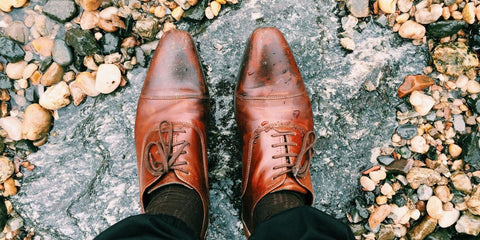No Products in the Cart
- FREE DELIVERY ON ALL ORDERS ABOVE 5000/- PKR.

Your footwear makes a statement before you do, but monsoon rains can quickly turn stylish shoes into a soggy mess. Water exposure weakens adhesives, damages leather, and encourages mold growth. Whether you’re commuting or taking a stroll, wet conditions can ruin your favorite pairs.
But don’t worry! This guide will help you protect, clean, and maintain your shoes, keeping them fresh and damage-free throughout the rainy season.
Let’s dive in!
Taking proper care of your footwear during monsoon isn’t just about cleaning—it’s about preventing damage before it even happens. Protecting and caring for all types of footwear require a proactive approach. Here are some tried-and-tested strategies to help your shoes survive the rainy season.
Prevention is better than cure. If you want to avoid excessive shoe maintenance, invest in the right footwear for monsoon. Instead of wearing delicate materials, opt for shoes made from water-resistant materials like rubber, synthetic leather, or treated canvas.
Rubber boots or gumboots – Perfect for heavy rains, they provide maximum protection.
Synthetic leather shoes – Easier to clean and more durable than genuine leather.
Mesh or waterproof sneakers – These dry quickly and are comfortable for daily wear.
If you must wear leather shoes, apply a high-quality waterproof spray to create a protective layer against water damage.
The first and most important step in monsoon shoe care is waterproofing. Even if you’re not buying new shoes, you can waterproof your existing ones with simple methods:
Apply a waterproof spray – Works well on leather, suede, and canvas shoes.
Use wax polish – Ideal for leather shoes, adding an extra layer of water resistance.
Try beeswax – Rubbing beeswax on your shoes before heading out in the rain can keep moisture away.
Polishing isn’t just about aesthetics—it creates a protective layer that prevents moisture absorption. Use a good-quality shoe polish and apply it with a soft cloth or horsehair brush in circular motions.
For leather shoes, a wax-based polish is ideal, as it helps repel water while keeping the leather soft and supple. Make sure to polish your shoes at least twice a week for the best protection.
Rainwater often carries dirt, grime, and other pollutants that can leave stains on your shoes. The longer you wait, the harder it is to remove them.
Here’s how you can clean different types of shoes:
Leather shoes – Mix a small amount of water with a few drops of lemon juice or a mild leather cleaner.
Suede shoes – Use a suede brush or a white eraser to remove marks.
Fabric or canvas shoes – A mixture of baking soda and water works wonders for deep cleaning.
After cleaning, allow your shoes to air dry completely before wearing them again.
If your shoes get muddy or soaked, don’t let the dirt sit for too long. Wash or clean them as soon as possible to prevent long-term damage.
For protecting leather shoes in rainy season, use a specialized leather cleaner to avoid cracks or stiffness. For sneakers or synthetic shoes, mild soap and water should do the trick. Always use a soft brush or sponge to prevent damage to the material.
When not in use, store your footwear in designated shoe bags to keep dust and moisture away. Adding silica gel packets inside your shoes can help absorb excess moisture, preventing mold and unpleasant odors.
This is a great way to keep your shoes fresh and dry when you’re not wearing them.
A damp environment can quickly lead to mold and mildew growth on your footwear. To avoid this, place a dehumidifier in your shoe cabinet.
It helps regulate moisture levels, keeping your shoes in excellent condition even during the wettest days. If you don’t have a dehumidifier, placing charcoal or baking soda inside the cabinet can also absorb excess humidity.
While it’s important to dry wet shoes, never place them directly under the sun or near heaters. Excessive heat can cause synthetic materials to warp and leather to crack.
Instead, let them air dry at room temperature. If needed, use a fan or stuff newspaper inside to speed up the drying process.
Wet shoes tend to lose their shape over time. Inserting shoe trees—preferably made of unfinished cedar wood—helps maintain their structure while also absorbing excess moisture.
This simple step ensures your shoes stay in good condition throughout the monsoon.
Never store damp shoes! Trapped moisture leads to foul odors, bacterial growth, and material deterioration. To ensure your shoes are completely dry before storage, stuff them with tissue paper or dry cloth to absorb any remaining moisture.
This helps maintain their shape and prevents unpleasant smells.
Sometimes, you need a fast and effective way to clean your shoes before heading out. Here’s a simple three-step method to freshen up your footwear in no time:
By incorporating these quick fixes into your routine, you can ensure your shoes always look fresh and well-maintained.
Taking care of your footwear during monsoon requires a mix of preventive measures and regular maintenance. From waterproofing and polishing to proper storage and drying, these tips will help keep your shoes looking great despite the wet and muddy conditions.
By following these shoe cleaning tips for rainy season, you can extend the lifespan of your footwear while keeping them stylish and comfortable.
At Moriox Shoes, we offer a wide range of monsoon-friendly footwear that combines durability, comfort, and style. If you’re looking for the perfect pair of to brave the rains, explore our collection today!
What do you think of these tips? Let us know, and share this guide with anyone who might find it useful. Wishing you a hassle-free monsoon with clean and well-protected footwear!